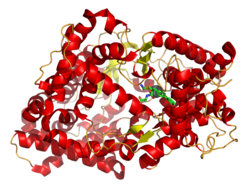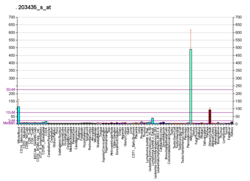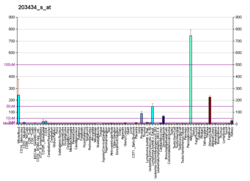Néprilysine
La néprilysine (ou antigène Calla pour « common acute lymphoblastic leukemia antigen », ou CD10 ou endopeptidase neutre) est une enzyme métalloprotéase dépendante du zinc. Cette molécule est utilisée comme marqueur de plusieurs cancers. Son gène est le MME (de l'anglais : « membrane metallo-endopeptidase ») situé sur le chromosome 3 humain.
Elle est inhibée par le sacubitril, un médicament commercialisé en association avec le valsartan dans le traitement de l'insuffisance cardiaque, ainsi que par l’omapatrilate.
Structure
modifierIl s'agit d'une enzyme membranaire mais une forme soluble (libre) existe. Elle est exprimée dans tous les organes[5]. Elle peut être relarguée par l'endothélium vasculaire par exosomes, régulée par l'ADAM 17[6].
Effets
modifierL’inhibition de la néprilysine potentialise l'action de la bradykinine chez les patients traités par un inhibiteur de l'enzyme de conversion, entraînant une vasodilatation accrue des artères[7]. Cette dernière peut également être provoquée par une potentialisation de l'adrénomédulline provoquée par l'inhibition de la néprilysine[8].
Son blocage augmente également, chez un modèle animal, la sécrétion du facteur natriurétique cérébral (BNP) et du facteur natriurétique auriculaire[9], entraînant une augmentation de la diurèse. En contrepartie, les facteurs natriurétiques inhibent la néprilysine[10].
Elle hydrolyse les endothélines, les inactivant, en particulier dans leurs propriétés vasoconstrictrices[11].
Elle intervient dans la régulation des cellules souches[12].
Au niveau cérébral, elle dégrade les chaînes bêta-amyloïdes ce qui en fait une piste pour le traitement de la maladie d'Alzheimer[13].
En médecine
modifierLe taux de néprilysine circulante semble être un marqueur de gravité chez les patients en insuffisance cardiaque[14].
Elle est inhibée par le sacubitril, maintenant recommandé en Europe dans l'insuffisance cardiaque en 3ème ligne de traitement en association avec le valsartan[15].
Son inhibition semble également protectrice des néphrons chez le patient diabétique[16].
Lors d'une maladie d'Alzheimer, l'expression de la néprilysine est réduite dans certaines zones du cerveau[17] et certains variants du gène augmente la susceptibilité à cette maladie[18]. Ces données font que les médicaments testés comme inhibiteurs de la néprilysine pourraient avoir un effet indésirable sur la fonction cognitive s'ils passent la barrière hémato-encéphalique, ce qui ne semble pas être le cas[19].
Notes et références
modifier- GRCh38: Ensembl release 89: ENSG00000196549 - Ensembl, May 2017
- GRCm38: Ensembl release 89: ENSMUSG00000027820 - Ensembl, May 2017
- ↑ « Publications PubMed pour l'Homme », sur National Center for Biotechnology Information, U.S. National Library of Medicine
- ↑ « Publications PubMed pour la Souris », sur National Center for Biotechnology Information, U.S. National Library of Medicine
- ↑ Erdös EG, Skidgel RA, Neutral endopeptidase 24.11 (enkephalinase) and related regulators of peptide hormones, FASEB J, 1989;3:145–151
- ↑ Kuruppu S, Rajapakse NW, Minond D, Smith AI, Production of soluble NEP by endothelial cells, Biochem Biophys Res Commun, 2004;446:423–427
- ↑ Cruden NL, Fox KA, Ludlam CA, Johnston NR, Newby DE, Neutral endopeptidase inhibition augments vascular actions of bradykinin in patients treated with angiotensin-converting enzyme inhibition, Hypertension, 2004;44:913-918
- ↑ Wilkinson IB, McEniery CM, Bongaerts KH, MacCallum H, Webb DJ, Cockcroft JR, Adrenomedullin (ADM) in the human forearm vascular bed: effect of neutral endopeptidase inhibition and comparison with proadrenomedullin NH2-terminal 20 peptide (PAMP), Br J Clin Pharmacol, 2001;52:159-164
- ↑ Rademaker MT, Charles CJ, Espiner EA, Nicholls MG, Richards AM, Kosoglou T, Neutral endopeptidase inhibition: augmented atrial and brain natriuretic peptide, haemodynamic and natriuretic responses in ovine heart failure, Clin Sci (Lond), 1996;91:283-291
- ↑ Vodovar N, Seronde MF, Laribi S et al. Elevated plasma B-Type natriuretic peptide concentrations directly inhibit circulating neprilysin activity in heart failure, JACC Heart Fail, 2015;3:629–636
- ↑ Vijayaraghavan J, Scicli AG, Carretero OA, Slaughter C, Moomaw C, Hersh LB, The hydrolysis of endothelins by neutral endopeptidase 24.11 (enkephalinase), J Biol Chem, 1990;265:14150–14155
- ↑ Maguer-Satta V, Besançon R, Bachelard-Cascales E, Concise review: neutral endopeptidase (CD10): a multifaceted environment actor in stem cells, physiological mechanisms, and cancer, Stem Cells, 2011;29:389–396
- ↑ Iwata N, Higuchi M, Saido TC, Metabolism of amyloid-beta peptide and Alzheimer's disease, Pharmacol Therap, 2005;108:129–148
- ↑ Bayés-Genís A, Barallat J, Galán A et al. Soluble neprilysin is predictive of cardiovascular death and heart failure hospitalization in heart failure patients, JACC, 2015;65:657–665
- ↑ Piotr Ponikowski, Adriaan A. Voors, Stefan D. Anker et Héctor Bueno, « 2016 ESC Guidelines for the diagnosis and treatment of acute and chronic heart failureThe Task Force for the diagnosis and treatment of acute and chronic heart failure of the European Society of Cardiology (ESC)Developed with the special contribution of the Heart Failure Association (HFA) of the ESC », European Heart Journal, vol. 37, no 27, , p. 2129–2200 (ISSN 0195-668X, DOI 10.1093/eurheartj/ehw128, lire en ligne, consulté le )
- ↑ Maric C, Zheng W, Walther T, Interactions between angiotensin ll and atrial natriuretic peptide in renomedullary interstitial cells: the role of neutral endopeptidase, Nephron Physiol, 2006;103:149-156
- ↑ Yasojima K, Akiyama H, McGeer EG, McGeer PL, Reduced neprilysin in high plaque areas of Alzheimer brain: a possible relationship to deficient degradation of beta-amyloid peptide, Neurosci Lett, 2001;297:97–100
- ↑ Vepsalainen S, Helisalmi S, Mannermaa A, Pirttila T, Soininen H, Hiltunen M, Combined risk effects of IDE and NEP gene variants on Alzheimer disease, J Neurol Neurosurg Psychiatry, 2009;80:1268–1270
- ↑ Vodovar N, Paquet C, Mebazaa A, Launay JM, Hugon J, Cohen-Solal A, Neprilysin, cardiovascular, and Alzheimer's diseases: the therapeutic split?, Eur Heart J, 2015;36:902-905






